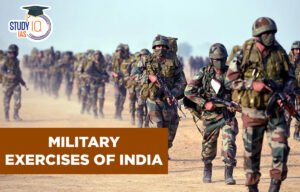Table of Contents
Global Positioning System (GPS)
Context: GPS technology revolutionises diverse sectors from agriculture to military, enhancing precision, efficiency, and safety in operations and decision-making.
Overview Of Global Positioning System (GPS)
- The GPS program, initiated by the S. Department of Defence in 1973, launched its first satellite in 1978.
- It operates on a satellite-based navigation system comprising roughly 24 satellites positioned in a strategic manner.
- These satellites are distributed across six earth orbits and each completes two orbits daily.
We’re now on WhatsApp. Click to Join
Three Main Components Of GPS
- Space Segment: This segment includes 24 satellites distributed across six orbits, each orbiting 20,200 km above the Earth and hosting four satellites.
- This spatial arrangement ensures a minimum of four satellites are visible from any point on Earth, a vital aspect of GPS functionality.
- Control Segment: This involves a network of ground-based control stations and antennas globally, responsible for tracking the satellites, ensuring their optimal performance, and sending necessary commands.
- The control segment plays a crucial role in upholding these service commitments.
- User Segment: This segment refers to the practical application of GPS across various sectors.
- Key sectors utilising GPS technology include agriculture, construction, surveying, logistics, telecommunications, power transmission, search and rescue operations, air travel, meteorology, seismology, and military operations.
- The user segment reflects the broad and diverse applications of GPS technology in different fields.
Working Of GPS
- Signal Transmission and Information: The signal transmitted by each GPS satellite carries vital details about its location in orbit and its operational state, including the precise time the signal was dispatched.
- Distance Calculation by GPS Receiver: The GPS receiver uses the information in these signals to accurately determine its distance from each satellite.
- Location Triangulation Using Four Satellites: The process involves signals from at least four satellites, enabling the GPS receiver to precisely triangulate its position on the Earth’s surface.
- Importance of Precise Timekeeping: The exact time when the signal is sent from the satellite and received by the GPS receiver is critical in measuring the distance. Each satellite is equipped with an atomic clock to ensure highly accurate time measurement, which is essential for distance calculations.
Countries With GNSS
- Russia– GLONASS
- European Union– Galileo
- China– BeiDou
- India– Navigation with Indian Constellation (NavIC)
About NavIC
- Indian Regional Navigation Satellite System (IRNSS)/NavIC: Initiated in 2006, it was later renamed as Navigation with Indian Constellation (NavIC) developed by ISRO.
- It’s specifically designed to provide accurate positioning services over India and the surrounding region.
- Space Segment: NavIC’s space segment comprises seven satellites, with three in geostationary orbits and four in geosynchronous orbits.
- By May 2023, the system’s minimum four satellites were capable of supporting ground-based navigation.
- Control Facilities: The system’s master control facilities are situated in Hassan, Karnataka, and Bhopal, Madhya Pradesh.
- Technical Features: NavIC satellites are equipped with rubidium atomic clocks.
- They transmit data in the L5 and S bands, and the newer satellites also use the L1 band.
- The system includes a unique messaging interface capable of receiving and transmitting specific messages, like alerts to fishermen about international border proximity.
- GPS-Aided Geo Augmented Navigation (GAGAN): India also operates GAGAN, a system developed in collaboration between ISRO and the Airports Authority of India, aimed at enhancing GPS signals for aviation purposes.
Aspirational District Programme
Context: Prime Minister Narendra Modi highlighted the significant role of poor, deprived, and tribal communities from aspirational districts and tribal-reserved areas, marking a pivotal shift in the political landscape of these traditionally underdeveloped regions.
What is Aspirational District Programme?
The Prime Minister of India initiated the ‘Transformation of Aspirational Districts Programme (ADP)’ in January 2018 to address socio-economic challenges in specific regions.
Aspirational Districts Programme (ADP) Overview
- Goal: The program aims to rapidly enhance the socio-economic status of 117 districts across 28 states.
- State-Driven Approach: It emphasises leveraging each district’s unique strengths and focuses on achievable outcomes for swift improvements.
- Monitoring Mechanism: A collaborative effort with the NITI Aayog and the Government of Andhra Pradesh led to the development of the ‘Champions of Change-Real-Time Monitoring Dashboard’ to track the progress of these districts.
Objectives of ADP
- Skill Mapping: To identify and map the skill profile of each district.
- Ecosystem Appraisal: To evaluate the existing skill ecosystem in the district.
- Challenge Identification: To pinpoint district-specific challenges and determine the necessary support areas.
- Skill Development Plan: To develop a District Skill Development Plan through a consultative process.
- Implementation Support: To provide assistance in implementing the work plans for the districts.
Core Principles of ADP
- Convergence: Integrating Central and State Government schemes for a unified approach.
- Collaboration: Fostering partnerships among citizens, Central and State Government functionaries, including district teams.
- Competition: Encouraging a competitive spirit among districts to foster improvement and innovation.
Parameters for Ranking
The ranking is based on the incremental progress made across 49 Key Performance Indicators (KPIs) under 5 broad socio-economic themes
- Health & Nutrition (30%)
- Education (30%)
- Agriculture & Water Resources (20%)
- Financial Inclusion & Skill Development (10%)
- Infrastructure (10%)
The Global Climate 2011-2020: A Decade of Acceleration
Context: Recently, ‘the Global Climate 2011-2020: A Decade of Acceleration’ report was released by the World Meteorological Organisation.
Key Findings
- Record Warmth: This period has been identified as the warmest in recorded history, indicating a clear trend of global warming.
- Economic Losses vs. Decrease in Deaths: Despite an increase in economic losses due to extreme weather and climate events, there has been a notable decrease in the number of deaths resulting from these events.
- Decline in Casualties: The reduction in casualties from extreme weather and climate events is substantial, primarily attributed to enhanced early warning systems, improved forecasting, and more effective disaster management.
- Ozone Layer Recovery: For the first time, the decade showed visible signs of recovery in the depleted ozone layer, marking a significant environmental milestone.
- Global Glacier Thinning: Glaciers around the world, on average, have thinned by approximately one metre per year between 2011 and 2020.
- Ice Loss in Greenland and Antarctica: These regions experienced a 38% increase in ice loss compared to the previous decade (2001-2010).
- Impact of Human-Caused Climate Change: The report highlighted that human-induced climate change significantly heightens risks associated with extreme heat events.
- Heatwaves have been the leading cause of human casualties in this context, while tropical cyclones have caused the most economic damage.
- Financial Trends in Climate Action: There was almost a doubling of public and private climate finance during this decade.
- However, to maintain global temperature increases within 1.5 degrees Celsius by the century’s end, this financial commitment needs to increase by at least sevenfold.
| Health Repository under the AD program |
|
Loan Write Off
Context: Over half of the total loans written off by Scheduled Commercial Banks in (FY23) belonged to large industries and services sector, as per data presented by the Ministry of Finance.
Loan Write-offs
- A loan is an asset on the balance sheet of a bank, lent out of depositor’s money.
- Writing off a loan essentially means it will no longer be counted as an asset.
- The bank writes off a loan after the borrower has defaulted on the loan repayment and there is a very low chance of recovery.
Importance of Loan Write-offs
- Impact on NPAs: Loan write-offs help banks reduce their non-performing assets (NPAs), improving their financial health.
- Tax Benefits: The amount written off can lower the bank’s taxable income.
Reasons for Loan Write-offs
- Default and Low Recovery Prospects: Banks usually write off loans when the borrower defaults and the likelihood of recovering the loan is minimal.
- Not Necessarily Lost Funds: It’s crucial to understand that not all loan write-offs equate to lost money.
- Ongoing Recovery Efforts: Many loans that are written off remain under the bank’s monitoring, and efforts to recover dues continue.
- Preservation of Recovery Rights: Writing off a loan doesn’t hinder a bank’s legal right to pursue the borrower for repayment.
- Recovery as Profit: Any amount recovered from a written-off loan is recorded as profit in the financial year it’s received.
Mount Marapi
Context: Eleven hikers have been found dead near the crater of Indonesia’s Mount Marapi volcano after it erupted.
About Mount Marapi
- Mount Merapi is situated near the centre of Java Island in Indonesia.
- Java is central among Indonesia’s more than 18,000 islands, not Sumatra.
- The mountain stands at a height of 2,891 metres.
- Known as “Mountain of Fire,” Mount Merapi is one of Indonesia’s most active volcanoes.
- It is a popular destination for hiking enthusiasts.
- Indonesia, including Mount Merapi, is part of the Pacific Ring of Fire, a region with high volcanic and seismic activity due to tectonic plate movements.
|
Important Fact |
| Pacific Ring of Fire, also known as the Circum-Pacific Belt,is a path along the Pacific Ocean characterised by active volcanoes and frequent earthquakes. |


 List of Military Exercises of India 2024...
List of Military Exercises of India 2024...
 India to Host First Global Conference on...
India to Host First Global Conference on...
 How Terror Networks Abuse Digital Tools
How Terror Networks Abuse Digital Tools





















